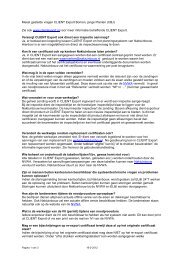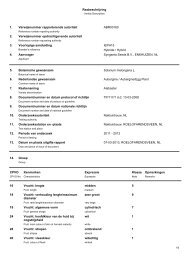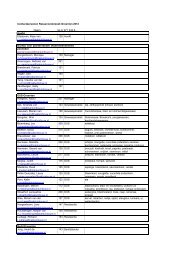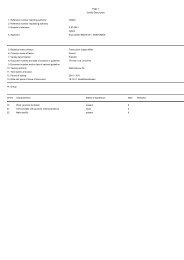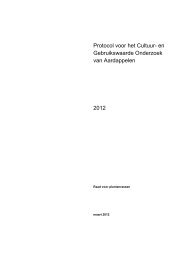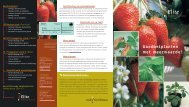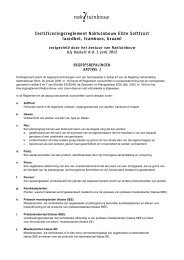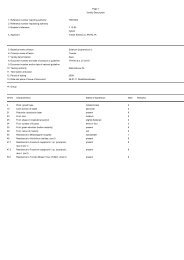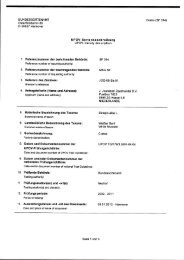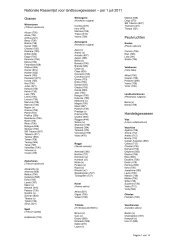CPVO protocol TP/48/2 - Naktuinbouw
CPVO protocol TP/48/2 - Naktuinbouw
CPVO protocol TP/48/2 - Naktuinbouw
Create successful ePaper yourself
Turn your PDF publications into a flip-book with our unique Google optimized e-Paper software.
European Union<br />
Community Plant Variety Office<br />
<strong>CPVO</strong>-<strong>TP</strong>/0<strong>48</strong>/2 Final<br />
English<br />
Date: 01/12/2005<br />
PROTOCOL FOR DISTINCTNESS, UNIFORMITY AND STABILITY TESTS<br />
Brassica oleracea L. var. capitata L.<br />
CABBAGE<br />
UPOV Species Code: BRASS_OLE_GC<br />
Adopted on 01/12/2005
I - SUBJECT OF THE PROTOCOL<br />
<strong>CPVO</strong>-<strong>TP</strong>/0<strong>48</strong>/2 Final<br />
English<br />
Date: 01/12/2005<br />
The <strong>protocol</strong> describes the technical procedures to be followed in order to meet the<br />
Council Regulation 2100/94 on Community Plant Variety Rights. The technical<br />
procedures have been agreed by the Administrative Council and are based on general<br />
UPOV Document TG/1/3 and UPOV Guideline TG/<strong>48</strong>/7 dated 31/03/2004 for the conduct<br />
of tests for Distinctness, Uniformity and Stability. This <strong>protocol</strong> applies to varieties of<br />
Brassica oleracea L. var. capitata L., including Brassica oleracea L. convar. capitata<br />
(L.) Alef. var. alba DC [white cabbage], Brassica oleracea L. convar. capitata (L.)<br />
Alef. var. rubra DC [red cabbage] and Brassica oleracea L. convar. capitata (L.) Alef.<br />
var. sabauda DC [savoy cabbage]<br />
II - SUBMISSION OF SEED AND OTHER PLANT MATERIAL<br />
1. The Community Plant Variety Office (<strong>CPVO</strong>) is responsible for informing the<br />
applicant of<br />
• the closing date for the receipt of plant material;<br />
• the minimum amount and quality of plant material required;<br />
• the examination office to which material is to be sent.<br />
A sub-sample of the material submitted for test will be held in the variety collection as the<br />
definitive sample of the candidate variety.<br />
The applicant is responsible for ensuring compliance with any customs and plant health<br />
requirements.<br />
2. Final dates for receipt of documentation and material by the Examination Office<br />
The final dates for receipt of requests, technical questionnaires and the final date or<br />
submission period for plant material will be decided by the <strong>CPVO</strong> and each Examination<br />
Office chosen.<br />
The Examination Office is responsible for immediately acknowledging the receipt of<br />
requests for testing, and technical questionnaires. Immediately after the closing date for the<br />
receipt of plant material the Examination Office should inform the <strong>CPVO</strong> whether<br />
acceptable plant material has been received or not. However if unsatisfactory plant<br />
material is submitted the <strong>CPVO</strong> should be informed as soon as possible.<br />
2
3. Plant material requirements<br />
<strong>CPVO</strong>-<strong>TP</strong>/0<strong>48</strong>/2 Final<br />
English<br />
Date: 01/12/2005<br />
The final dates for request for technical examination and sending of Technical<br />
Questionnaire as well as submission date of plant material by the applicant, and quantity of<br />
plant material to be supplied by the applicant are published on the <strong>CPVO</strong> website and in<br />
the S2 official gazette.<br />
Quality of seed: Should not be less than the standards laid down for certified<br />
seed in Annex 2 of EC Directive 2002/55/EC.<br />
Seed Treatment: The plant material must not have undergone any treatment<br />
unless the <strong>CPVO</strong> and the examination office allow or request<br />
such treatment. If it has been treated, full details of the<br />
treatment must be given.<br />
Special requirements: -<br />
Labelling of sample: - Species<br />
- File number of the application allocated by the <strong>CPVO</strong><br />
- Breeder's reference<br />
- Examination reference (if known)<br />
- Name of applicant<br />
- The phrase “On request of the <strong>CPVO</strong>”.<br />
- In the case of a split sample, the quantity of seed being<br />
submitted<br />
III - CONDUCT OF TESTS<br />
1. Variety collection<br />
A variety collection will be maintained for the purpose of establishing distinctness of the<br />
candidate varieties in test. A variety collection may contain both living material and<br />
descriptive information. A variety will be included in a variety collection only if plant<br />
material is available to make a technical examination.<br />
Pursuant to Article 7 of Council Regulation No. 2100/94, the basis for a collection should<br />
be the following:<br />
• varieties listed or protected at the EU level or at least in one of the EEA Member States;<br />
• varieties protected in other UPOV Member States;<br />
• any other variety in common knowledge.<br />
The composition of the variety collection in each Examination Office depends on the<br />
environmental conditions in which the Examination Office is located.<br />
3
<strong>CPVO</strong>-<strong>TP</strong>/0<strong>48</strong>/2 Final<br />
English<br />
Date: 01/12/2005<br />
Variety collections will be held under conditions which ensure the long term maintenance<br />
of each accession. It is the responsibility of Examination Offices to replace reference<br />
material which has deteriorated or become depleted. Replacement material can only be<br />
introduced if appropriate tests confirm conformity with the existing reference material. If<br />
any difficulties arise for the replacement of reference material Examination Offices must<br />
inform the <strong>CPVO</strong>. If authentic plant material of a variety cannot be supplied to an<br />
Examination Office the variety will be removed from the variety collection.<br />
2. Material to be examined<br />
Candidate varieties will be directly compared with other candidates for Community plant<br />
variety rights tested at the same Examination Office, and with appropriate varieties in the<br />
variety collection. When necessary an Examination Office may also include other<br />
candidates and varieties. Examination Offices should therefore make efforts to co-ordinate<br />
the work with other Offices involved in DUS testing of cabbage. There should be at least<br />
an exchange of technical questionnaires for each candidate variety, and during the test<br />
period, Examination Offices should notify each other and the <strong>CPVO</strong> of candidate varieties<br />
which are likely to present problems in establishing distinctness. In order to solve<br />
particular problems Examination Offices may exchange plant material.<br />
3. Characteristics to be used<br />
The characteristics to be used in DUS tests and preparation of descriptions shall be those<br />
referred to in the Annex 1. All the characteristics shall be used, providing that observation<br />
of a characteristic is not rendered impossible by the expression of any other characteristic,<br />
or the expression of a characteristic is prevented by the environmental conditions under<br />
which the test is conducted. In the latter case, the <strong>CPVO</strong> should be informed. In addition<br />
the existence of some other regulation e.g. plant health, may make the observation of the<br />
characteristic impossible.<br />
The Administrative Council empowers the President, in accordance with Article 23 of<br />
Commission Regulation N° 1239/95, to insert additional characteristics and their<br />
expressions in respect of a variety.<br />
4
4. Grouping of varieties<br />
<strong>CPVO</strong>-<strong>TP</strong>/0<strong>48</strong>/2 Final<br />
English<br />
Date: 01/12/2005<br />
The varieties and candidates to be compared will be divided into groups to facilitate the<br />
assessment of distinctness. Characteristics which are suitable for grouping purposes are<br />
those which are known from experience not to vary, or to vary only slightly, within a<br />
variety and which in their various states of expression are fairly evenly distributed<br />
throughout the collection. In the case of continuous grouping characteristics overlapping<br />
states of expression between adjacent groups is required to reduce the risks of incorrect<br />
allocation of candidates to groups. The characters used for grouping are the following:<br />
a) Outer leaf: colour (with wax) (characteristic 11)<br />
b) Head: shape in longitudinal section (characteristic 17)<br />
c) Head: diameter (characteristic 20)<br />
d) Head: density (characteristic 30)<br />
e) Time of harvest maturity (characteristic 33)<br />
5. Trial designs and growing conditions<br />
The minimum duration of tests will normally be two independent growing cycles. For<br />
vegetatively propagated varieties, the duration of the testing may be reduced to one<br />
growing cycle if the results on distinctness and uniformity are conclusive. Tests will be<br />
carried out under conditions ensuring normal growth. The size of the plots will be such that<br />
plants or parts of plants may be removed for measuring and counting without prejudice to<br />
the observations which must be made up to the end of the growing period.<br />
The test design is as follows:<br />
As a minimum, each test should include a total of 40 plants divided between two<br />
replicates.<br />
All observations determined by measurement or counting should be made on 20 plants or<br />
parts of 20 plants.<br />
6. Special tests<br />
In accordance with Article 83(3) of Council Regulation No. 2100/94 an applicant may<br />
claim either in the Technical Questionnaire or during the test that a candidate has a<br />
characteristic which would be helpful in establishing distinctness. If such a claim is made<br />
and is supported by reliable technical data, a special test may be undertaken providing that<br />
a technically acceptable test procedure can be devised.<br />
5
<strong>CPVO</strong>-<strong>TP</strong>/0<strong>48</strong>/2 Final<br />
English<br />
Date: 01/12/2005<br />
Special tests will be undertaken, with the agreement of the President of <strong>CPVO</strong>, where<br />
distinctness is unlikely to be shown using the characters listed in the <strong>protocol</strong>.<br />
7. Standards for decisions<br />
a) Distinctness<br />
A candidate variety will be considered to be distinct if it meets the requirements of Article<br />
7 of Council Regulation No. 2100/94.<br />
b) Uniformity<br />
For the assessment of uniformity of:<br />
(i) - cross pollinated and hybrid varieties (excluding single cross hybrids), relative<br />
uniformity standards should be applied.<br />
(ii) – vegetatively propagated varieties, single cross hybrids and inbred lines , a population<br />
standard of 1% and an acceptance probability of at least 95% should be applied.<br />
Table of maximum numbers of off-types allowed for uniformity standards for vegetatively<br />
propagated varieties, single cross hybrids and inbred lines.<br />
c) Stability<br />
Number of plants off-types allowed<br />
36 - 82 2<br />
A candidate will be considered to be sufficiently stable when there is no evidence to<br />
indicate that it lacks uniformity.<br />
6
IV - REPORTING OF RESULTS<br />
<strong>CPVO</strong>-<strong>TP</strong>/0<strong>48</strong>/2 Final<br />
English<br />
Date: 01/12/2005<br />
After each recording season the results will be summarised and reported to the <strong>CPVO</strong> in<br />
the form of a UPOV model interim report in which any problems will be indicated under<br />
the headings distinctness, uniformity and stability. Candidates may meet the DUS<br />
standards after two growing periods but in some cases three growing periods may be<br />
required. When tests are completed the results will be sent by the Examination Office to<br />
the <strong>CPVO</strong> in the form of a UPOV model final report.<br />
If it is considered that the candidate complies with the DUS standards, the final report will<br />
be accompanied by a variety description in the format recommended by UPOV. If not the<br />
reasons for failure and a summary of the test results will be included with the final report.<br />
The <strong>CPVO</strong> must receive interim reports and final reports by the date agreed between the<br />
<strong>CPVO</strong> and the examination office.<br />
Interim reports and final examination reports shall be signed by the responsible member of<br />
the staff of the Examination Office and shall expressly acknowledge the exclusive rights of<br />
disposal of <strong>CPVO</strong>.<br />
V - LIAISON WITH THE APPLICANT<br />
If problems arise during the course of the test the <strong>CPVO</strong> should be informed immediately<br />
so that the information can be passed on to the applicant. Subject to prior agreement, the<br />
applicant may be directly informed at the same time as the <strong>CPVO</strong> particularly if a visit to<br />
the trial is advisable.<br />
The interim report as well as the final report shall be sent by the Examination Office to the<br />
<strong>CPVO</strong>.<br />
**********<br />
7
ANNEXES TO FOLLOW<br />
<strong>CPVO</strong>-<strong>TP</strong>/0<strong>48</strong>/2 Final<br />
English<br />
Date: 01/12/2005<br />
ANNEX I PAGE<br />
Table of characteristics .................................................................................................. 10<br />
R = red cabbage<br />
S = savoy cabbage<br />
W = white cabbage<br />
Types of expression of characteristics:<br />
QL – Qualitative characteristic<br />
QN – Quantitative characteristic<br />
PQ – Pseudo-qualitative characteristic<br />
Type of observation of characteristics:<br />
MG – Single measurement of a group of plants or parts of plants<br />
MS – Measurement of a number of individual plants or parts of plants<br />
VG – Visual assessment by a single observation of a group of plants or parts of plants<br />
VS – Visual assessment by observation of individual plants or parts of plants<br />
When a method of observation is attributed to a certain characteristic, the first differentiation<br />
is made depending if the action taken is a visual observation (V) or a measurement (M).<br />
The second differentiation deals with the number of observations the expert attributes to each<br />
variety, thus the attribution of either G or S.<br />
If a single observation of a group consisting of an undefined number of individual plants is<br />
appropriate to assess the expression of a variety, we talk about a visual observation or a<br />
measurement made on a group of plants, thus we attribute the letter G (either VG or MG). If<br />
the expert makes more than one observation on that group of plants, the decisive part is that<br />
we have at the end only one data entry per variety which means that we have to deal with G<br />
(e.g. measurement of plant length on a plot – MG, visual observation of green colour of<br />
leaves on a plot – VG).<br />
If it is necessary to observe a number of individual plants to assess the expression of a variety,<br />
we should attribute the letter S (thus either VS or MS). Single plant data entries are kept per<br />
variety for further calculations like the variety mean (e.g. measurement of length of ears –<br />
MS, visual observation of growth habit of single plants in grasses – VS). The number of<br />
individual plants to be observed in such cases is stated in section III.5.<br />
Explanations and methods ............................................................................................. 20<br />
Literature ........................................................................................................................ 25<br />
8
ANNEX II<br />
Technical Questionnaire<br />
<strong>CPVO</strong>-<strong>TP</strong>/0<strong>48</strong>/2 Final<br />
English<br />
Date: 01/12/2005<br />
9
<strong>CPVO</strong><br />
No.<br />
ANNEX I<br />
<strong>CPVO</strong>-<strong>TP</strong>/0<strong>48</strong>/2 Final<br />
English<br />
Date: 01/12/2005<br />
TABLE OF CHARACTERISTICS TO BE USED IN DUS-TEST AND<br />
PREPARATION OF DESCRIPTIONS<br />
UPOV<br />
No.<br />
1.1 1.1 White cabbage varieties only: Plant: height<br />
Characteristics Examples Note<br />
QN QN very short 1<br />
VG VG short Gouden Akker, Minicole 3<br />
medium Marner Lagerweiss, Strukton 5<br />
tall Amager hochstrunkig, Thurner,<br />
Zerlina<br />
very tall Filderkraut 9<br />
1.2 1.2 Red cabbage varieties only: Plant: height<br />
QN QN very short Langedijker Allervroegste, Primero 1<br />
VG VG short Marner Frührotkohl, Ruby Ball 3<br />
medium Allrot, Roxy 5<br />
tall Langedijker Bewaar 3,<br />
Langedijker Herfst, Rovita<br />
very tall 9<br />
1.3 1.3 Savoy cabbage varieties only: Plant: height<br />
QN QN very short 1<br />
VG VG short Fitis, Vorbote 2 3<br />
medium Marner Grünkopf 5<br />
tall Hammer, Roi de l’hiver 2 7<br />
very tall Bloemendaalse Gele 9<br />
2.1 2.1 White cabbage varieties only: Plant:<br />
maximum diameter (including outer leaves)<br />
QN QN small Wiam 3<br />
VG VG medium Marner Augustkohl 5<br />
large Roem van Enkhuizen 2, Robuster 7<br />
10<br />
7<br />
7
<strong>CPVO</strong><br />
No.<br />
UPOV<br />
No.<br />
2.2 2.2 Red cabbage varieties only:<br />
Plant: maximum diameter (as for 2.1)<br />
<strong>CPVO</strong>-<strong>TP</strong>/0<strong>48</strong>/2 Final<br />
English<br />
Date: 01/12/2005<br />
Characteristics Examples Note<br />
QN QN small Frührot, Primero 3<br />
VG VG medium Allrot, Ruby Ball 5<br />
large Marner Septemberrot, Rovita 7<br />
2.3 2.3 Savoy cabbage varieties only:<br />
Plant: maximum diameter (as for 2.1)<br />
QN QN small Vorbote 2 3<br />
VG VG medium Marner Grünkopf 5<br />
3. 3. Plant: length of outer stem<br />
large Hammer 7<br />
QN QN short Braunschweiger (W), Minicole (W),<br />
Vorox (R), Spivoy (S)<br />
VG/MS VG/MS medium Bartolo (W), September (W),<br />
Langedijker Bewaar 2 (R), Belvoy(S)<br />
long Amager hochstrunkig (W),<br />
Robuster (W), Pampa (S)<br />
4. 4. Plant: attitude of outer leaves<br />
QN QN erect Filderkraut (W), Slawdena (W) 3<br />
VG VG semi-erect Braunschweiger (W) 5<br />
prostrate Christmas Drumhead (W),<br />
Spring Hero (W)<br />
5.1 5.1 White cabbage varieties only:<br />
Outer leaf: size<br />
QN QN small Golden Cross 3<br />
VG VG medium Atria, Braunschweiger,<br />
Marner Lagerweiss<br />
large Robuster, Thurner 7<br />
11<br />
3<br />
5<br />
7<br />
7<br />
5
<strong>CPVO</strong><br />
No.<br />
UPOV<br />
No.<br />
5.2 5.2 Red cabbage varieties only:<br />
Outer leaf: size<br />
<strong>CPVO</strong>-<strong>TP</strong>/0<strong>48</strong>/2 Final<br />
English<br />
Date: 01/12/2005<br />
Characteristics Examples Note<br />
QN QN small Langedijker Allervroegste, Primero 3<br />
VG VG medium Langedijker Vroege, Ruby Ball 5<br />
large Langedijker Herfst, Marner Lagerrot,<br />
Rovita<br />
5.3 5.3 Savoy cabbage varieties only:<br />
Outer leaf: size<br />
QN QN small Promasa 3<br />
VG VG medium Belvoy 5<br />
6. 6. Outer leaf: shape of blade<br />
large Vertus 3 7<br />
(+) (+) elliptic Filderkraut (W) 1<br />
PQ PQ broad ovate September (W) 2<br />
VG VG circular Wiam (W) 3<br />
transverse broad elliptic Rookie (R) 4<br />
obovate Marksman (W) 5<br />
7. 7. Outer leaf: profile of upper side of blade<br />
QN QN concave Slawdena (W), Celsa (S) 1<br />
VG VG plane Golden Cross (W), Allrot (R) 2<br />
convex Comparsa (S) 3<br />
8.1 8.1 White and red cabbage varieties only:<br />
Outer leaf: degree of blistering<br />
QN QN absent or very weak Slawdena (W), Rookie (R) 1<br />
VG VG moderate Fieldrocket (W),<br />
Langedijker Herfst (R)<br />
strong Roem van Enkhuizen 3 (W),<br />
Kissendrup (R)<br />
12<br />
7<br />
2<br />
3
<strong>CPVO</strong><br />
No.<br />
UPOV<br />
No.<br />
8.2 8.2 Savoy cabbage varieties only: Outer leaf:<br />
degree of blistering<br />
<strong>CPVO</strong>-<strong>TP</strong>/0<strong>48</strong>/2 Final<br />
English<br />
Date: 01/12/2005<br />
Characteristics Examples Note<br />
QN QN absent or very weak De Pointoise 2 1<br />
VG VG weak Celsa 3<br />
medium Savoy King 5<br />
strong Hammer 7<br />
very strong Novusa, Roi de l’hiver 2 9<br />
9.1 9.1 White and red cabbage varieties only:<br />
Outer leaf: size of blisters<br />
QN QN small Hispi (W), Allrot (R) 3<br />
VG VG medium Roem van Enkhuizen 2 (W),<br />
Kissendrup (R)<br />
large Jason (W) 7<br />
9.2 9.2 Savoy cabbage varieties only:<br />
Outer leaf: size of blisters<br />
QN QN small Roi de l’hiver 2 3<br />
VG VG medium Hammer 5<br />
large Vertus 2 7<br />
10. 10. Savoy cabbage varieties only:<br />
Outer leaf: crimping<br />
(+) (+) weak Dauerwirsing 3<br />
medium Savoy King 5<br />
VG VG strong Hammer 7<br />
11. 11. Outer leaf: colour (with wax)<br />
(+) (+) yellow green April (W) 1<br />
PQ PQ green Hammer (S) 2<br />
VG VG grey green Bison (W), Gloria (W),<br />
Roi de l'hiver 2 (S)<br />
blue green Market Prize (W) 4<br />
G violet Langedijker Bewaar 2 (R) 5<br />
13<br />
5<br />
3
<strong>CPVO</strong><br />
No.<br />
UPOV<br />
No.<br />
12. 12. Outer leaf: intensity of colour<br />
<strong>CPVO</strong>-<strong>TP</strong>/0<strong>48</strong>/2 Final<br />
English<br />
Date: 01/12/2005<br />
Characteristics Examples Note<br />
QN QN light Gouden Akker (W), Rebus (R),<br />
Bloemendaalse Gele (S)<br />
VG VG medium Cabri (W), Redsky (R), Kilosa (S) 5<br />
13. 13. Red cabbage varieties only:<br />
Outer leaf: green flush<br />
dark Excel (W), Integro (R), Norma (S) 7<br />
QL QL absent Autoro, Kissendrup 1<br />
VG VG present Kempero, Roxy 9<br />
14. 14. Outer leaf: waxiness<br />
QN QN absent or very weak First of June (W) 1<br />
VG VG weak Derby Day (W), Octoking (W) 3<br />
medium Wiam (W), Celtic(S) 5<br />
strong Thurner (W), Bison (W) 7<br />
very strong Rivera (W), Indaro(R) 9<br />
15. 15. Outer leaf: undulation of margin<br />
QN QN absent or very weak Minicole (W) 1<br />
VG VG weak Holsteiner platter (W) 3<br />
medium Saturn (W), Dacato (S) 5<br />
strong Snovoy (S) 7<br />
very strong Roxy (R) 9<br />
16. 16. Outer leaf: reflexion of margin<br />
QL QL absent Slawdena (W) 1<br />
VG VG present Rinda (W) 9<br />
14<br />
3
<strong>CPVO</strong><br />
No.<br />
UPOV<br />
No.<br />
17. 17. Head: shape in longitudinal section<br />
<strong>CPVO</strong>-<strong>TP</strong>/0<strong>48</strong>/2 Final<br />
English<br />
Date: 01/12/2005<br />
Characteristics Examples Note<br />
(+) (+) transverse narrow elliptic Braunschweiger (W) 1<br />
PQ PQ transverse elliptic Centurion (W), Conquistador (W),<br />
De Pointoise 2 (S)<br />
VG VG circular Octoking (W),<br />
Roem van Enkhuizen 2 (W)<br />
broad elliptic Langedijker Herfst (R) 4<br />
broad obovate Langedijker Bewaar (W) 5<br />
broad ovate Cape Horn (W) 6<br />
G angular ovate Filderkraut (W), Hispi (W) 7<br />
18. 18. Head: shape of base in longitudinal section<br />
(+) (+) rounded 1<br />
PQ PQ flat 2<br />
VG VG arched 3<br />
19. 19. Head: length<br />
QN QN short Marner Allfrüh (W), Vorbote 2 (S) 3<br />
VG/MS VG/MS medium Belvoy (S), Pampa (S) 5<br />
20. 20. Head: diameter<br />
long Offenham 3 (W) 7<br />
QN QN small Marner Allfrüh (W), Vorbote 2 (S) 3<br />
VG/MS VG/MS medium Celsa (S), Pampa (S) 5<br />
G large Braunschweiger (W),<br />
Quintal d'Alsace (W)<br />
21. 21. Head: position of maximum diameter<br />
QN QN towards top Slawdena (W) 1<br />
VG VG at middle Derby Day (W), Gouden Akker (W) 2<br />
towards base Hispi (W) 3<br />
15<br />
2<br />
3<br />
7
<strong>CPVO</strong><br />
No.<br />
UPOV<br />
No.<br />
22. 22. Head: cover<br />
<strong>CPVO</strong>-<strong>TP</strong>/0<strong>48</strong>/2 Final<br />
English<br />
Date: 01/12/2005<br />
Characteristics Examples Note<br />
(+) (+) not covered Late Putjes (S) 1<br />
QN QN partially covered Holsteiner platter (W) 2<br />
VG VG covered Langedijker Bewaar 2 (R) 3<br />
23. 23. Savoy cabbage varieties only:<br />
Head: blistering of cover leaf<br />
QN QN absent or very weak De Pointoise 2 1<br />
VG VG weak Celtic 3<br />
medium Julius 5<br />
strong Hammer 7<br />
very strong Roi de l'hiver 2 9<br />
24. 24. Head: reflexion of margin of cover leaf<br />
QL QL absent Apex(W), Morgan (W) 1<br />
VG VG present Orbit (W) 9<br />
25. 25. Head: colour of cover leaf<br />
(+) (+) yellow green April (W), Octoking (W) 1<br />
PQ PQ green Hammer (S) 2<br />
VG VG grey green Roi de l'hiver 2 (S) 3<br />
blue green 4<br />
violet Kissendrup (R) 5<br />
26. 26. Head: intensity of colour of cover leaf 3<br />
QN QN light<br />
VG VG medium 5<br />
dark 7<br />
16
<strong>CPVO</strong><br />
No.<br />
UPOV<br />
No.<br />
27. 27. White cabbage and Savoy cabbage varieties<br />
only: Head: anthocyanin coloration of<br />
cover leaf<br />
<strong>CPVO</strong>-<strong>TP</strong>/0<strong>48</strong>/2 Final<br />
English<br />
Date: 01/12/2005<br />
Characteristics Examples Note<br />
QN QN absent or very weak Hammer (S) 1<br />
VG VG weak Slawdena (W) 3<br />
28. 28. Head: internal colour<br />
medium De Pontoise 2 (S) 5<br />
strong Marabel (S) 7<br />
very strong 9<br />
PQ PQ whitish Slawdena (W) 1<br />
VG VG yellowish Langedijker Bewaargele (S) 2<br />
greenish 3<br />
violet Langedijker Herfst (R) 4<br />
29. 29. Red cabbage varieties only: Head: intensity<br />
of internal colour<br />
QN QN light 3<br />
VG VG medium 5<br />
30. 30. Head: density<br />
dark 7<br />
(+) (+) very loose Mignon (W) 1<br />
QN QN loose Hornspi (W) 3<br />
VG VG medium Dacato (S), Spivoy (S) 5<br />
dense Pampa (S) 7<br />
G very dense Slawdena (W) 9<br />
31. 31. Head: internal structure<br />
(+) (+) fine Slawdena (W), Quintal d'Alsace (W) 3<br />
QN QN medium Langedijker Herfst (R) 5<br />
VG VG coarse Filderkraut (W),<br />
Roem van Enkhuizen 2 (W)<br />
17<br />
7
<strong>CPVO</strong><br />
No.<br />
UPOV<br />
No.<br />
32. 32. Head: relative length of interior stem<br />
compared to length of head<br />
<strong>CPVO</strong>-<strong>TP</strong>/0<strong>48</strong>/2 Final<br />
English<br />
Date: 01/12/2005<br />
Characteristics Examples Note<br />
(+) (+) short Erdeno (W) 3<br />
QN QN medium Slawdena (W)<br />
VG VG long Braunschweiger (W), Belvoy (S) 7<br />
33.1 33.1 White cabbage varieties only:<br />
Time of harvest maturity<br />
QN QN very early Golden Cross 1<br />
VG VG early Green Express, Hijula 3<br />
medium Roem van Enkhuizen 2 5<br />
late Holsteiner platter,<br />
Marner Lagerweiss, Strukton<br />
G very late Bartolo 9<br />
33.2 33.2 Red cabbage varieties only:<br />
Time of harvest maturity<br />
QN QN early Langedijker Vroege, Normiro,<br />
Ruby Ball<br />
VG VG medium Autoro, Langedijker Herfst,<br />
Marner Septemberrot<br />
G late Huzaro, Langedijker Bewaar 2,<br />
Marner Lagerrot<br />
33.3 33.3 Savoy cabbage varieties only:<br />
Time of harvest maturity<br />
QN QN very early Spivoy 1<br />
VG VG early Walasa 3<br />
medium Belvoy 5<br />
late Hammer 7<br />
G very late Alexander’s N°1 9<br />
18<br />
7<br />
3<br />
5<br />
7
<strong>CPVO</strong><br />
No.<br />
UPOV<br />
No.<br />
34. 34. Time of bursting of head after maturity<br />
<strong>CPVO</strong>-<strong>TP</strong>/0<strong>48</strong>/2 Final<br />
English<br />
Date: 01/12/2005<br />
Characteristics Examples Note<br />
QN QN early Winnigstadt (W), Primero (R),<br />
Curosa (S)<br />
VG VG medium Excel (W), Pluton (R),<br />
Ruby Ball (R), Emerald (S)<br />
35. 35. Male sterility<br />
late Quisto (W), Induro (R), Ermosa (S) 7<br />
(+) (+) absent Winnigstadt (W), Pluton (R),<br />
Belvoy (S)<br />
QL<br />
VS<br />
<strong>CPVO</strong><br />
No.<br />
36.<br />
(+)<br />
QL<br />
VS<br />
present Unifor (W), Roderick (R),<br />
Emerald (S)<br />
Note: Only resistances marked with an asterisk (*) are compulsory.<br />
In general for the assessment of resistance characteristics, the facilities of other<br />
Examination Offices or specialised institutions might be used, subject to previous<br />
arrangements.<br />
Some characteristics may be discarded: if there are already phytosanitary restrictions.<br />
UPOV<br />
No.<br />
36.<br />
(+)<br />
Characteristics Examples Note<br />
Resistance to race 1 of Fusarium<br />
oxysporum f. sp. conglutinans<br />
QL QL absent Roem van Enkhuizen 2(W) 1<br />
VS VS present Delight YR(W), Gloria (W) 9<br />
19<br />
3<br />
5<br />
1<br />
9
Ad 6: Outer leaf: shape of blade<br />
EXPLANATIONS AND METHODS<br />
1 2 3<br />
elliptic broad elliptic circular<br />
4 5<br />
transverse broad elliptic obovate<br />
The leaf should be flattened out as far as possible before observation.<br />
Ad 10: Savoy cabbage varieties only: Outer leaf: crimping<br />
Crimping is the undulation of the leaf blade tissue between the secondary veins.<br />
Ad 11 and 25: Outer leaf: colour (with wax); Head: colour of cover leaf<br />
<strong>CPVO</strong>-<strong>TP</strong>/0<strong>48</strong>/2 Final<br />
English<br />
Date: 01/12/2005<br />
States 1 to 4 apply to white and Savoy cabbage only and state 5, violet, is only to be used for<br />
red cabbage varieties.<br />
20
Ad 17: Head: shape in longitudinal section<br />
1 2 3 4<br />
transverse narrow transverse elliptic circular broad elliptic<br />
elliptic<br />
5 6 7<br />
broad obovate broad ovate angular ovate<br />
Ad 18: Head: shape of base in longitudinal section<br />
1 2 3<br />
rounded flat arched<br />
<strong>CPVO</strong>-<strong>TP</strong>/0<strong>48</strong>/2 Final<br />
English<br />
Date: 01/12/2005<br />
21
Ad 22: Head: cover<br />
1 2 3<br />
not covered partially covered covered<br />
Ad 30: Head: density<br />
1 3 5<br />
very loose loose medium<br />
7 9<br />
dense very dense<br />
<strong>CPVO</strong>-<strong>TP</strong>/0<strong>48</strong>/2 Final<br />
English<br />
Date: 01/12/2005<br />
22
Ad 31: Head: internal structure<br />
3 5 7<br />
Fine medium coarse<br />
Ad 32: Head: relative length of interior stem compare to length of head<br />
<strong>CPVO</strong>-<strong>TP</strong>/0<strong>48</strong>/2 Final<br />
English<br />
Date: 01/12/2005<br />
short (note 3) – relative length of interior stem approximately 1/8 compared to length of head<br />
medium (note 5) – relative length of interior stem approximately 1/4 compared to length of<br />
head<br />
long (note 7) – relative length of interior stem approximately 1/2 compared to length of head<br />
Ad 35: Male sterility<br />
Check presence of pollen on stamen:<br />
(a) if pollen on stamen is present than male sterility is absent;<br />
(b) if pollen on stamen is absent than male sterility is present.<br />
Note: for F1 hybrids, depending on the composition of the parent lines, male<br />
sterility may not be fully present<br />
Ad 36: Resistance to race 1 of Fusarium oxysporum f. sp. conglutinans<br />
Records must be taken under conditions of controlled infection.<br />
Maintenance of races<br />
Type of medium: on agar medium at 20°C<br />
Special conditions multiplication by passing on parts of the agar medium to<br />
liquid Czapek-Dox-Broth. This liquid medium must be<br />
shaken permanently.<br />
23
Execution of test<br />
Growth stage of plants: young plants, about two weeks after sowing<br />
Temperature: about 25°C<br />
Light: normal glasshouse conditions<br />
<strong>CPVO</strong>-<strong>TP</strong>/0<strong>48</strong>/2 Final<br />
English<br />
Date: 01/12/2005<br />
Growing method: seeds sown in peat soil at rather low temperature: 12 –<br />
14°C during day time and 10 – 12°C during night time<br />
Method of inoculation: roots of lifted young plants are soaked for 5 minutes in a<br />
suspension of spores and parts of mycelium, thereafter<br />
replanting<br />
Duration of test:<br />
- from sowing to inoculation: 2 weeks<br />
- from inoculation to reading: first symptoms 7 days after inoculation, final reading<br />
18 days after inoculation<br />
Number of plants tested: 20<br />
Remarks: The disease might be a quarantine-disease in some<br />
countries.<br />
Race 1 of this pathogen is common; very rarely other races<br />
occur.<br />
* * * * * * * *<br />
24
LITERATURE<br />
<strong>CPVO</strong>-<strong>TP</strong>/0<strong>48</strong>/2 Final<br />
English<br />
Date: 01/12/2005<br />
– HIGGINS, J., SPARKS, T.H., EVANS, J.L. and LAW, J.R., 1986: "Crop Identification<br />
of Some Brassica oleracea Cultivars," Acta Horticulturae, 182, pp. 285-291<br />
– JENSMA, J.R., 1956: "Cabbage Varieties," Instituut voor de veredeling van<br />
tuinbouwgewassen, Wageningen, NL<br />
– NIEUWHOF, 1969: "Cole Crops: Botany, Cultivation and Utilization," London,<br />
Leonard Hill, GB<br />
– SIEMONSMA and PILUK, 1993: “Plant resources of South-East Asia 8, Vegetables”,<br />
Prosea 8<br />
– TSUNODA, S., HINATA, K. and GOMEZ-CAMPO, C., 1980: "Brassica Crops and<br />
Wild Allies - Biology and Breeding," Japan Scientific Societies Press, Tokyo, JP<br />
25
ANNEX II<br />
European Union<br />
Community Plant Variety Office<br />
TECHNICAL QUESTIONNAIRE<br />
to be completed in connection with an application for Community Plant Variety Rights<br />
Please answer all questions. A question without any answer will lead to a non-attribution<br />
of an application date. In cases where a field / question is not applicable, please state so.<br />
<strong>CPVO</strong>-<strong>TP</strong>/0<strong>48</strong>/2 Final<br />
English<br />
Date: 01/12/2005<br />
1. Botanical taxon: Name of the genus, species or sub-species to which the variety belongs and<br />
common name<br />
[ ] Brassica oleracea L. convar. capitata (L.) Alef. var. alba D.C.<br />
WHITE CABBAGE<br />
[ ] Brassica oleracea L. convar. capitata (L.) Alef. var. rubra D.C.<br />
RED CABBAGE<br />
[ ] Brassica oleracea L. convar. capitata (L.) Alef. var. sabauda D.C.<br />
SAVOY CABBAGE<br />
[ ] Intersubspecific hybrids of the above groups (give details)<br />
2. Applicant(s): Name(s) and address(es), phone and fax number(s), Email address, and where<br />
appropriate name and address of the procedural representative<br />
26
3. Variety denomination<br />
a) Where appropriate proposal for a variety denomination:<br />
b) Provisional designation (breeder’s reference):<br />
4. Information on origin, maintenance and reproduction of the variety<br />
4.1 Method of maintenance and reproduction<br />
(a) (i) hybrid ................................................................................ [ ]<br />
(ii) open-pollinated variety ..................................................... [ ]<br />
(iii) parent line ........................................................................ [ ]<br />
(b) (i) seed propagated ................................................................. [ ]<br />
(ii) vegetatively propagated .................................................... [ ]<br />
(c ) Other informatiuon on genetic and breeding method ............. [ ]<br />
<strong>CPVO</strong>-<strong>TP</strong>/0<strong>48</strong>/2 Final<br />
English<br />
Date: 01/12/2005<br />
4.2 Geographical origin of the variety: the region and the country in which the variety was bred or<br />
discovered and developed<br />
27
<strong>CPVO</strong>-<strong>TP</strong>/0<strong>48</strong>/2 Final<br />
English<br />
Date: 01/12/2005<br />
4.3 Shall the information on data relating to components of hybrid varieties including data<br />
related to their cultivation be treated as confidential?<br />
[ ] YES [ ] NO<br />
If yes, please give this information on the attached form for confidential information.<br />
If no, please give information on data relating to components of hybrid varieties including data<br />
related to their cultivation:<br />
Breeding scheme (indicate female component first)<br />
5. Characteristics of the variety to be indicated (the number in brackets refers to the<br />
corresponding characteristic in the <strong>CPVO</strong> Protocol; please mark the state of expression<br />
which best corresponds).<br />
5.1.1<br />
(1.1)<br />
5.1.2<br />
(1.2)<br />
Characteristics Example varieties Note<br />
White cabbage varieties only: Plant: height<br />
very short 1 [ ]<br />
short Gouden Akker, Minicole 3 [ ]<br />
medium Marner Lagerweiss, Strukton 5 [ ]<br />
tall Amager hochstrunkig, Thurner, Zerlina 7 [ ]<br />
very tall Filderkraut 9 [ ]<br />
Red cabbage varieties only: Plant: height<br />
very short Langedijker Allervroegste, Primero 1 [ ]<br />
short Marner Frührotkohl, Ruby Ball 3 [ ]<br />
medium Allrot, Roxy 5 [ ]<br />
tall Langedijker Bewaar 3,<br />
Langedijker Herfst, Rovita<br />
7 [ ]<br />
very tall 9 [ ]<br />
28
5.1.3<br />
(1.3)<br />
5.2.1<br />
(5.1)<br />
5.2.2<br />
(5.2)<br />
5.2.3<br />
(5.3)<br />
5.3.1<br />
(8.1)<br />
<strong>CPVO</strong>-<strong>TP</strong>/0<strong>48</strong>/2 Final<br />
English<br />
Date: 01/12/2005<br />
Characteristics Example varieties Note<br />
Savoy cabbage varieties only: Plant: height<br />
very short 1 [ ]<br />
short Fitis, Vorbote 2 3 [ ]<br />
medium Marner Grünkopf 5 [ ]<br />
tall Hammer, Roi de l’hiver 2 7 [ ]<br />
very tall Bloemendaalse Gele 9 [ ]<br />
White cabbage varieties only: Outer leaf: size<br />
small Golden Cross 3 [ ]<br />
medium Atria, Braunschweiger,<br />
Marner Lagerweiss<br />
5 [ ]<br />
large Robuster, Thurner 7 [ ]<br />
Red cabbage varieties only: Outer leaf: size<br />
small Langedijker Allervroegste, Primero 3 [ ]<br />
medium Langedijker Vroege, Ruby Ball 5 [ ]<br />
large Langedijker Herfst, Marner Lagerrot,<br />
Rovita<br />
Savoy cabbage varieties only: Outer leaf: size<br />
7 [ ]<br />
small Promosa 3 [ ]<br />
medium Belvoy 5 [ ]<br />
large Vertus 3 7 [ ]<br />
White and red cabbage varieties only: Outer leaf: degree of blistering<br />
absent or very weak Slawdena (W), Rookie (R) 1 [ ]<br />
moderate Fieldrocket (W, Langedijker Herfst (R) 2 [ ]<br />
strong Roem van Enkhuizen 3 (W),<br />
Kissendrup (R)<br />
3 [ ]<br />
29
5.3.2<br />
(8.2)<br />
5.4<br />
(11)<br />
5.5<br />
(12)<br />
5.6<br />
(17)<br />
<strong>CPVO</strong>-<strong>TP</strong>/0<strong>48</strong>/2 Final<br />
English<br />
Date: 01/12/2005<br />
Characteristics Example varieties Note<br />
Savoy cabbage varieties only: Outer leaf: degree of blistering<br />
absent or very weak De Pontoise 2 1 [ ]<br />
weak Celsa 3 [ ]<br />
medium Savoy King 5 [ ]<br />
strong Hammer 7 [ ]<br />
very strong Novusa, Roi de l’hiver 2 9 [ ]<br />
Outer leaf: colour (with wax)<br />
yellow green April (W) 1 [ ]<br />
green Hammer (S) 2 [ ]<br />
grey green Bison (W), Gloria (W), Roi de l’hiver (S) 3 [ ]<br />
blue green Market Prize (W) 4 [ ]<br />
violet Langedijker Bewaar 2 (R) 5 [ ]<br />
Outer leaf: intensity of colour<br />
light Gouden Akker (W), Rebus (R),<br />
Bloemendaalse Gele (S)<br />
3 [ ]<br />
medium Cabri (W), Redsky (R), Kilosa (S) 5 [ ]<br />
dark Excel (W), Integro (R), Norma (S) 7 [ ]<br />
Head: shape of longitudinal section<br />
transverse narrow elliptic Braunschweiger (W) 1 [ ]<br />
transverse elliptic Centurion (W), Conquistador (W),<br />
De Pointoise 2 (S)<br />
circular Octoking (W),<br />
Roem van Enkhuizen 2 (W)<br />
2 [ ]<br />
3 [ ]<br />
broad elliptic Langedijker Herfst (R) 4 [ ]<br />
broad obovate Langedijker Bewaar (W) 5 [ ]<br />
broad ovate Cape Horn (W) 6 [ ]<br />
angular ovate Filderkraut (W), Hispi (W) 7 [ ]<br />
30
5.7<br />
(20)<br />
5.8<br />
(30)<br />
5.9.1<br />
(33.1)<br />
5.9.2<br />
(34.2)<br />
<strong>CPVO</strong>-<strong>TP</strong>/0<strong>48</strong>/2 Final<br />
English<br />
Date: 01/12/2005<br />
Characteristics Example varieties Note<br />
Head: diameter<br />
small Marner Allfrüh (W), Vorbote 2 (S) 3 [ ]<br />
medium Celsa (S), Pampa (S) 5 [ ]<br />
large Braunschweiger (W),<br />
Quintal d’Alsace (W)<br />
Head: density<br />
7 [ ]<br />
very loose Mignon (W) 1 [ ]<br />
loose Hornspi (W) 3 [ ]<br />
medium Dacato (S), Spivoy (S) 5 [ ]<br />
dense Pampa (S) 7 [ ]<br />
very dense Slawdena (W) 9 [ ]<br />
White cabbage varieties only: Time of harvest maturity<br />
very early Golden Cross 1 [ ]<br />
early Green Express, Hijula 3 [ ]<br />
medium Roem van Enkhuizen 2 5 [ ]<br />
late Holsteiner Platter, Marner Lagerweiss,<br />
Strukton<br />
7 [ ]<br />
very late Bartolo 9 [ ]<br />
Red cabbage varieties only: Time of harvest maturity<br />
early Langedijker Vroege, Normiro, Ruby Ball 3 [ ]<br />
medium Autoro, Langedijker Herfst,<br />
Marner Septemberrot<br />
late Huzaro, Langedijker Bewaar,<br />
Marner Lagerrot<br />
5 [ ]<br />
7 [ ]<br />
31
5.9.3<br />
(33.3)<br />
<strong>CPVO</strong>-<strong>TP</strong>/0<strong>48</strong>/2 Final<br />
English<br />
Date: 01/12/2005<br />
Characteristics Example varieties Note<br />
Savoy cabbage varieties only: Time of harvest maturity<br />
very early Spivoy 1 [ ]<br />
early Walasa 3 [ ]<br />
medium Belvoy 5 [ ]<br />
late Hammer 7 [ ]<br />
very late Alexander’s n°.1 9 [ ]<br />
6. Similar varieties and differences from these varieties:<br />
Denomination of<br />
similar variety<br />
____________<br />
1)<br />
Characteristic in which the<br />
similar variety is different 1)<br />
State of expression<br />
of similar variety<br />
State of expression of<br />
candidate variety<br />
In the case of identical states of expressions of both varieties, please indicate the size of the difference<br />
7. Additional information which may help to distinguish the variety<br />
A representative printed-out colour photo of the variety must be added to the Technical Questionnaire.<br />
7.1 Resistance to pests and diseases<br />
absent present not tested<br />
- Fusarium oxysporum f. sp. Conglutinans;(Characteristic 36) [ ] [ ] [ ]<br />
- Other (specify) [ ] [ ] [ ]<br />
32
7.2 Special conditions for the examination of the variety<br />
[ ] YES, please specify<br />
[ ] NO<br />
7.3 Other information<br />
[ ] YES, please specify<br />
[ ] NO<br />
8. GMO-information required<br />
<strong>CPVO</strong>-<strong>TP</strong>/0<strong>48</strong>/2 Final<br />
English<br />
Date: 01/12/2005<br />
The variety represents a Genetically Modified Organism within the meaning of Article 2(2)<br />
of Council Directive EC/2001/18 of 12/03/2001.<br />
[ ] YES [ ] NO<br />
If yes, please add a copy of the written attestation of the responsible authorities stating that a<br />
technical examination of the variety under Articles 55 and 56 of the Basic Regulation does<br />
not pose risks to the environment according to the norms of the above-mentioned Directive.<br />
33
9. Information on plant material to be examined<br />
<strong>CPVO</strong>-<strong>TP</strong>/0<strong>48</strong>/2 Final<br />
English<br />
Date: 01/12/2005<br />
9.1 The expression of a characteristic or several characteristics of a variety may be affected<br />
by factors, such as pests and disease, chemical treatment (e.g. growth retardants or<br />
pesticides), effects of tissue culture, different rootstocks, scions taken from different growth<br />
phases of a tree, etc.<br />
9.2 The plant material should not have undergone any treatment which would affect the<br />
expression of the characteristics of the variety, unless the competent authorities allow or<br />
request such treatment. If the plant material has undergone such treatment, full details of the<br />
treatment must be given. In this respect, please indicate below, to the best of your<br />
knowledge, if the plant material to be examined has been subjected to:<br />
(a) Microorganisms (e.g. virus, bacteria, phytoplasma) [ ] Yes [ ] No<br />
(b) Chemical treatment (e.g. growth retardant or pesticide) [ ] Yes [ ] No<br />
(c) Tissue culture [ ] Yes [ ] No<br />
(d) Other factors [ ] Yes [ ] No<br />
Please provide details of where you have indicated “Yes”:<br />
I/we hereby declare that to the best of my/our knowledge the information given in this form<br />
is complete and correct.<br />
Date Signature Name<br />
[End of document]<br />
34




